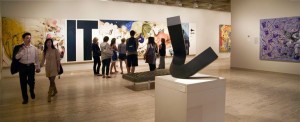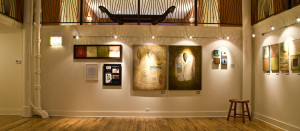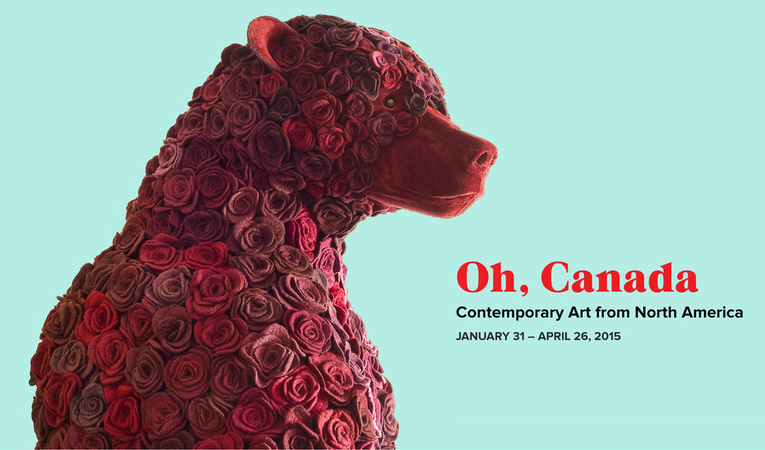While browsing
Brooklyn‘s art blog recently, I noticed that there were numerous articles on offer about the mechanisms of our impending doom–environmental and American–none of which I particularly wanted to read. The cultural pessimism of the moment was hard to ignore.
In the art world, too, there is a sense of foreboding. The often used metaphor of an art world “explosion” conveys the idea of general out-of-controlness. But then, considering the sheer volume of activity now available to the art observer, it is easy to feel overwhelmed.
Looked at objectively, however, the recent vitality of art should be seen in a positive light. Art is a form of enquiry, not a style or monetary investment. And when compared to the fate of other forms of modernist experimentation with which it shares origins–music and literature, for instance–visual art is thriving. It is a discipline that continues to find possible answers to questions that were posed over 100 years ago.

The audience for art is growing. Arguably, this is because of the myriad ways contemporary practice incorporates real world elements–including, in some cases, its audience–into itself. Although it still requires specialized knowledge to appreciate, contemporary art keeps pace with trends in our wider culture; a high-low dichotomy no longer applies.
There are a number of reasons for this push towards accessibility, among them the de-skilling of art practice, combined with an open-ended attitude about what can be art–both of which have deep roots in the philosophical questions past practitioners have asked.
A likely third factor is an anxiety on the part of practitioners about art’s relevance when compared to the sheer desirability of more commercial art forms, such as pop music and television.
An unintended consequence of this democratization is the loss of the allure that elitism once provided. Feelings of gloom about the art world can probably be calculated in inverse proportion to a loss of authority (real or imagined) on the part of those who are espousing them. Popularity always breeds a certain amount of resentment.
A related issue derives from the discipline-specific competence art now requires of artists that is not necessarily related to traditional notions of craft or skill–resulting in a widespread plausibility of a range of artistic practices with a concomitant relativisation of value.
It’s a multi-polar art world, in other words, and not everybody is happy about it. All this is just to say that art practice is undergoing the same process of fragmentation and de-hierarchization as are other precincts of culture, a phenomenon that is technological and economic in origin.
A reflection of this can be found in a recent trend in major art exhibitions: a deemphasis on art stars. This tendency, evident at last summer’s Documenta 12, and, more recently, the 5th Berlin Biennial, can be understood as a defensive position taken against a booming and overheated art market.

At these events in Kassel and Berlin, a curatorial resistance against an apparent status quo helped initiate particularized conversations about art. Both shows presented a disparate range of artists pursuing diverse lines of artistic enquiry, all relatively accessible and all equally valid. The net effect was, however, of a vast playing field of possibility upon which points of access and points of interest were somehow two different things.
This issue of
Art Journal, The Art System, addresses the structural aspects of art as a discipline and as an industry, and is comprised of examples from the broad spectrum of languages used to discuss art activity today, from news reports to highly speculative theoretical texts.
Chris Lloyd, an artist who devotes part of his practice to maintaining an ongoing correspondence with the Prime Minister of Canada, writes about the changing–and fast improving–climate of arts patronage in this country.
Lloyd discusses the newly established DHC/Art Foundation in Montreal, where he works as a technician, bringing to the topic the perspective of someone with extensive experience working in the artist-run sector. Lloyd’s text foregrounds the strange admixture in Canada of government support for artists and private patronage, and an underdeveloped art market, the result of which is that most artists cannot make a living wage in this country as artists. Despite promising developments like the DHC/ Art and collector Bob Rennie’s soon to be opened private gallery in Vancouver, it’s a situation that will in all likelihood continue to leave the majority of Canada’s art practitioners relatively impoverished.
Writing about the critic Hal Foster in this issue, Lydia Perovic provides historical perspective to this problem. Referring to Foster’s writings, Perovic discusses ideas about the true character of the avant-garde as it has functioned at various points in its history, and considers how these ideas might be useful when negotiating today’s hypertrophic art world.
Perovic shares with Marc James Leger, also writing in this issue, a suspicion of the neo-liberal appropriation of words like ‘creativity” In his article, Leger talks about the currently popular practice of ‘community art’ as a tendency that fosters the neutralization of activist impulse in art.
All of this begs two questions: is it possible to be prescriptive about the role of the artist in society? And has an inflated art market distorted expectations about what it means to be successful in art today?
 The audience for art is growing. Arguably, this is because of the myriad ways contemporary practice incorporates real world elements–including, in some cases, its audience–into itself. Although it still requires specialized knowledge to appreciate, contemporary art keeps pace with trends in our wider culture; a high-low dichotomy no longer applies.
There are a number of reasons for this push towards accessibility, among them the de-skilling of art practice, combined with an open-ended attitude about what can be art–both of which have deep roots in the philosophical questions past practitioners have asked.
A likely third factor is an anxiety on the part of practitioners about art’s relevance when compared to the sheer desirability of more commercial art forms, such as pop music and television.
An unintended consequence of this democratization is the loss of the allure that elitism once provided. Feelings of gloom about the art world can probably be calculated in inverse proportion to a loss of authority (real or imagined) on the part of those who are espousing them. Popularity always breeds a certain amount of resentment.
A related issue derives from the discipline-specific competence art now requires of artists that is not necessarily related to traditional notions of craft or skill–resulting in a widespread plausibility of a range of artistic practices with a concomitant relativisation of value.
It’s a multi-polar art world, in other words, and not everybody is happy about it. All this is just to say that art practice is undergoing the same process of fragmentation and de-hierarchization as are other precincts of culture, a phenomenon that is technological and economic in origin.
A reflection of this can be found in a recent trend in major art exhibitions: a deemphasis on art stars. This tendency, evident at last summer’s Documenta 12, and, more recently, the 5th Berlin Biennial, can be understood as a defensive position taken against a booming and overheated art market.
The audience for art is growing. Arguably, this is because of the myriad ways contemporary practice incorporates real world elements–including, in some cases, its audience–into itself. Although it still requires specialized knowledge to appreciate, contemporary art keeps pace with trends in our wider culture; a high-low dichotomy no longer applies.
There are a number of reasons for this push towards accessibility, among them the de-skilling of art practice, combined with an open-ended attitude about what can be art–both of which have deep roots in the philosophical questions past practitioners have asked.
A likely third factor is an anxiety on the part of practitioners about art’s relevance when compared to the sheer desirability of more commercial art forms, such as pop music and television.
An unintended consequence of this democratization is the loss of the allure that elitism once provided. Feelings of gloom about the art world can probably be calculated in inverse proportion to a loss of authority (real or imagined) on the part of those who are espousing them. Popularity always breeds a certain amount of resentment.
A related issue derives from the discipline-specific competence art now requires of artists that is not necessarily related to traditional notions of craft or skill–resulting in a widespread plausibility of a range of artistic practices with a concomitant relativisation of value.
It’s a multi-polar art world, in other words, and not everybody is happy about it. All this is just to say that art practice is undergoing the same process of fragmentation and de-hierarchization as are other precincts of culture, a phenomenon that is technological and economic in origin.
A reflection of this can be found in a recent trend in major art exhibitions: a deemphasis on art stars. This tendency, evident at last summer’s Documenta 12, and, more recently, the 5th Berlin Biennial, can be understood as a defensive position taken against a booming and overheated art market.
 At these events in Kassel and Berlin, a curatorial resistance against an apparent status quo helped initiate particularized conversations about art. Both shows presented a disparate range of artists pursuing diverse lines of artistic enquiry, all relatively accessible and all equally valid. The net effect was, however, of a vast playing field of possibility upon which points of access and points of interest were somehow two different things.
This issue of Art Journal, The Art System, addresses the structural aspects of art as a discipline and as an industry, and is comprised of examples from the broad spectrum of languages used to discuss art activity today, from news reports to highly speculative theoretical texts.
Chris Lloyd, an artist who devotes part of his practice to maintaining an ongoing correspondence with the Prime Minister of Canada, writes about the changing–and fast improving–climate of arts patronage in this country.
Lloyd discusses the newly established DHC/Art Foundation in Montreal, where he works as a technician, bringing to the topic the perspective of someone with extensive experience working in the artist-run sector. Lloyd’s text foregrounds the strange admixture in Canada of government support for artists and private patronage, and an underdeveloped art market, the result of which is that most artists cannot make a living wage in this country as artists. Despite promising developments like the DHC/ Art and collector Bob Rennie’s soon to be opened private gallery in Vancouver, it’s a situation that will in all likelihood continue to leave the majority of Canada’s art practitioners relatively impoverished.
Writing about the critic Hal Foster in this issue, Lydia Perovic provides historical perspective to this problem. Referring to Foster’s writings, Perovic discusses ideas about the true character of the avant-garde as it has functioned at various points in its history, and considers how these ideas might be useful when negotiating today’s hypertrophic art world.
Perovic shares with Marc James Leger, also writing in this issue, a suspicion of the neo-liberal appropriation of words like ‘creativity” In his article, Leger talks about the currently popular practice of ‘community art’ as a tendency that fosters the neutralization of activist impulse in art.
All of this begs two questions: is it possible to be prescriptive about the role of the artist in society? And has an inflated art market distorted expectations about what it means to be successful in art today?
At these events in Kassel and Berlin, a curatorial resistance against an apparent status quo helped initiate particularized conversations about art. Both shows presented a disparate range of artists pursuing diverse lines of artistic enquiry, all relatively accessible and all equally valid. The net effect was, however, of a vast playing field of possibility upon which points of access and points of interest were somehow two different things.
This issue of Art Journal, The Art System, addresses the structural aspects of art as a discipline and as an industry, and is comprised of examples from the broad spectrum of languages used to discuss art activity today, from news reports to highly speculative theoretical texts.
Chris Lloyd, an artist who devotes part of his practice to maintaining an ongoing correspondence with the Prime Minister of Canada, writes about the changing–and fast improving–climate of arts patronage in this country.
Lloyd discusses the newly established DHC/Art Foundation in Montreal, where he works as a technician, bringing to the topic the perspective of someone with extensive experience working in the artist-run sector. Lloyd’s text foregrounds the strange admixture in Canada of government support for artists and private patronage, and an underdeveloped art market, the result of which is that most artists cannot make a living wage in this country as artists. Despite promising developments like the DHC/ Art and collector Bob Rennie’s soon to be opened private gallery in Vancouver, it’s a situation that will in all likelihood continue to leave the majority of Canada’s art practitioners relatively impoverished.
Writing about the critic Hal Foster in this issue, Lydia Perovic provides historical perspective to this problem. Referring to Foster’s writings, Perovic discusses ideas about the true character of the avant-garde as it has functioned at various points in its history, and considers how these ideas might be useful when negotiating today’s hypertrophic art world.
Perovic shares with Marc James Leger, also writing in this issue, a suspicion of the neo-liberal appropriation of words like ‘creativity” In his article, Leger talks about the currently popular practice of ‘community art’ as a tendency that fosters the neutralization of activist impulse in art.
All of this begs two questions: is it possible to be prescriptive about the role of the artist in society? And has an inflated art market distorted expectations about what it means to be successful in art today? 